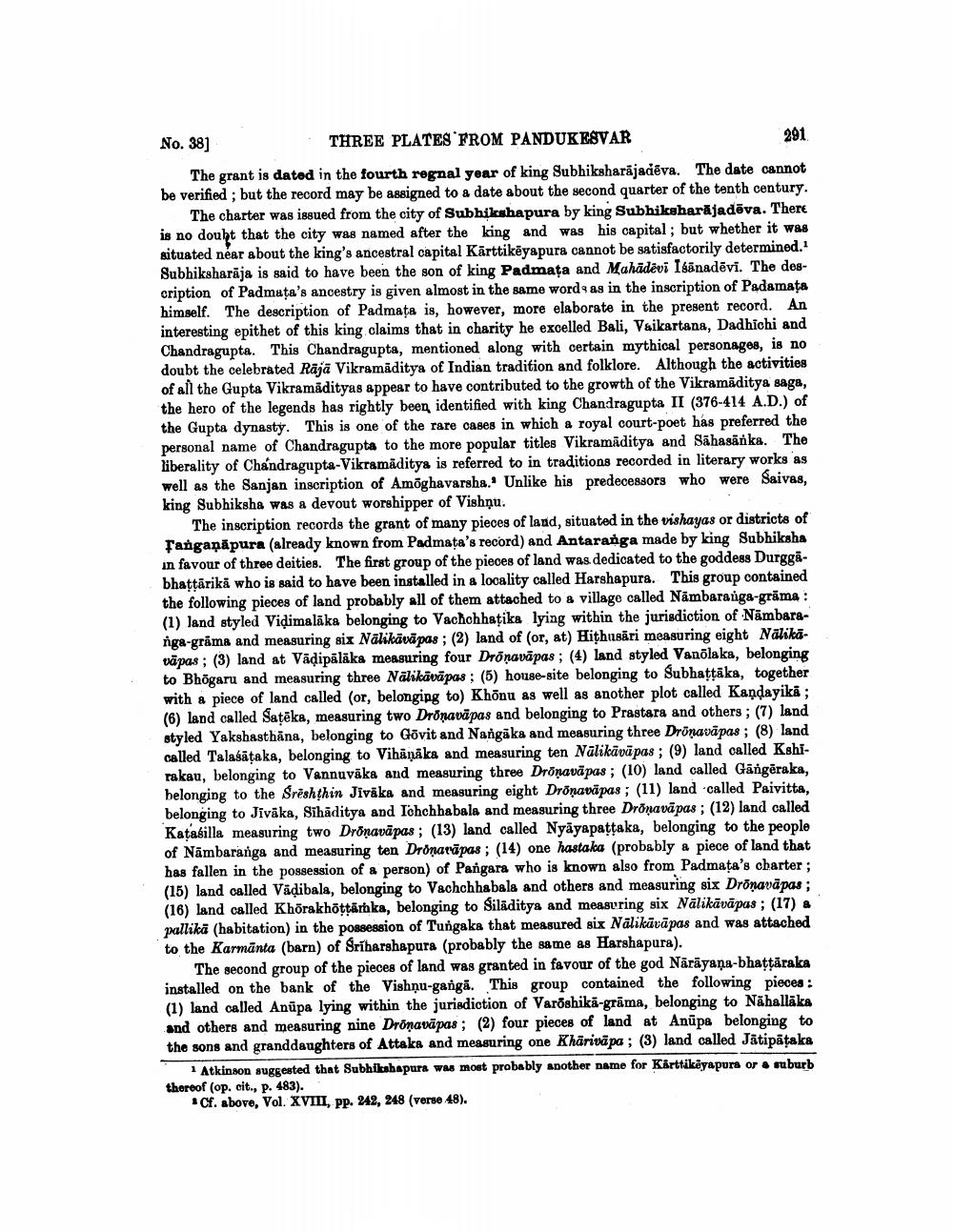________________
201
No. 38]
THREE PLATES FROM PANDUKESVAR
The grant is dated in the fourth regnal year of king Subhiksharajadeva. The date cannot be verified; but the record may be assigned to a date about the second quarter of the tenth century. The charter was issued from the city of Subhikshapura by king Subhiksharajadēva. There is no doubt that the city was named after the king and was his capital; but whether it was situated near about the king's ancestral capital Kärttikeyapura cannot be satisfactorily determined.1 Subhiksharaja is said to have been the son of king Padmata and Mahadevi Isanadēvi. The description of Padmata's ancestry is given almost in the same words as in the inscription of Padamata himself. The description of Padmața is, however, more elaborate in the present record. An interesting epithet of this king claims that in charity he excelled Bali, Vaikartana, Dadhichi and Chandragupta. This Chandragupta, mentioned along with certain mythical personages, is no doubt the celebrated Rājā Vikramaditya of Indian tradition and folklore. Although the activities of all the Gupta Vikramadityas appear to have contributed to the growth of the Vikramaditya saga, the hero of the legends has rightly been identified with king Chandragupta II (376-414 A.D.) of the Gupta dynasty. This is one of the rare cases in which a royal court-poet has preferred the personal name of Chandragupta to the more popular titles Vikramaditya and Sahasanka. The liberality of Chandragupta-Vikramaditya is referred to in traditions recorded in literary works as well as the Sanjan inscription of Amoghavarsha. Unlike his predecessors who were Saivas, king Subhiksha was a devout worshipper of Vishnu.
The inscription records the grant of many pieces of land, situated in the vishayas or districts of Fangaṇāpura (already known from Padmata's record) and Antaranga made by king Subhiksha in favour of three deities. The first group of the pieces of land was dedicated to the goddess Durggabhaṭṭārika who is said to have been installed in a locality called Harshapura. This group contained the following pieces of land probably all of them attached to a village called Nambaranga-grama: (1) land styled Viḍimalaka belonging to Vachchhatika lying within the jurisdiction of Nambaranga-grāma and measuring six Nälikäväpas; (2) land of (or, at) Hithusari measuring eight Nälikävapas; (3) land at Vaḍipālāka measuring four Drönavāpas; (4) land styled Vanōlaka, belonging to Bhogaru and measuring three Nälikäväpas; (5) house-site belonging to Subhaṭṭāka, together with a piece of land called (or, belonging to) Khonu as well as another plot called Kaṇḍayikā; (6) land called Satēka, measuring two Drönavapas and belonging to Prastara and others; (7) land styled Yakshasthana, belonging to Gōvit and Nangaka and measuring three Drönavapas; (8) land called Talasaṭaka, belonging to Vihanaka and measuring ten Nälikäväpas; (9) land called Kshirakau, belonging to Vannuvaka and measuring three Drönavapas; (10) land called Gängeraka, belonging to the Sreshthin Jiväka and measuring eight Dröṇavapas; (11) land called Paivitta, belonging to Jiväka, Sihaditya and Ichchhabala and measuring three Dronavāpas; (12) land called Katasilla measuring two Drönavapas; (13) land called Nyayapaṭṭaka, belonging to the people of Nambaranga and measuring ten Drönarapas; (14) one hastaka (probably a piece of land that has fallen in the possession of a person) of Pangara who is known also from Padmaṭa's charter; (15) land called Väḍibala, belonging to Vachchhabala and others and measuring six Drōnavapas; (16) land called Khörakhōṭṭäraka, belonging to Siladitya and measuring six Nälikäväpas; (17) a pallika (habitation) in the possession of Tungaka that measured six Nälikäväpas and was attached to the Karmanta (barn) of Sriharshapura (probably the same as Harshapura).
The second group of the pieces of land was granted in favour of the god Nārāyaṇa-bhaṭṭāraka installed on the bank of the Vishnu-ganga. This group contained the following pieces: (1) land called Anupa lying within the jurisdiction of Varōshika-grāma, belonging to Nähallāka and others and measuring nine Drönavapas; (2) four pieces of land at Anupa belonging to the sons and granddaughters of Attaka and measuring one Khäriväpa; (3) land called Jätipāṭaka
1 Atkinson suggested that Subhikshapura was most probably another name for Kärttikäyapura or a suburb thereof (op. cit., p. 483).
Cf. above, Vol. XVIII, pp. 242, 248 (verse 48).




